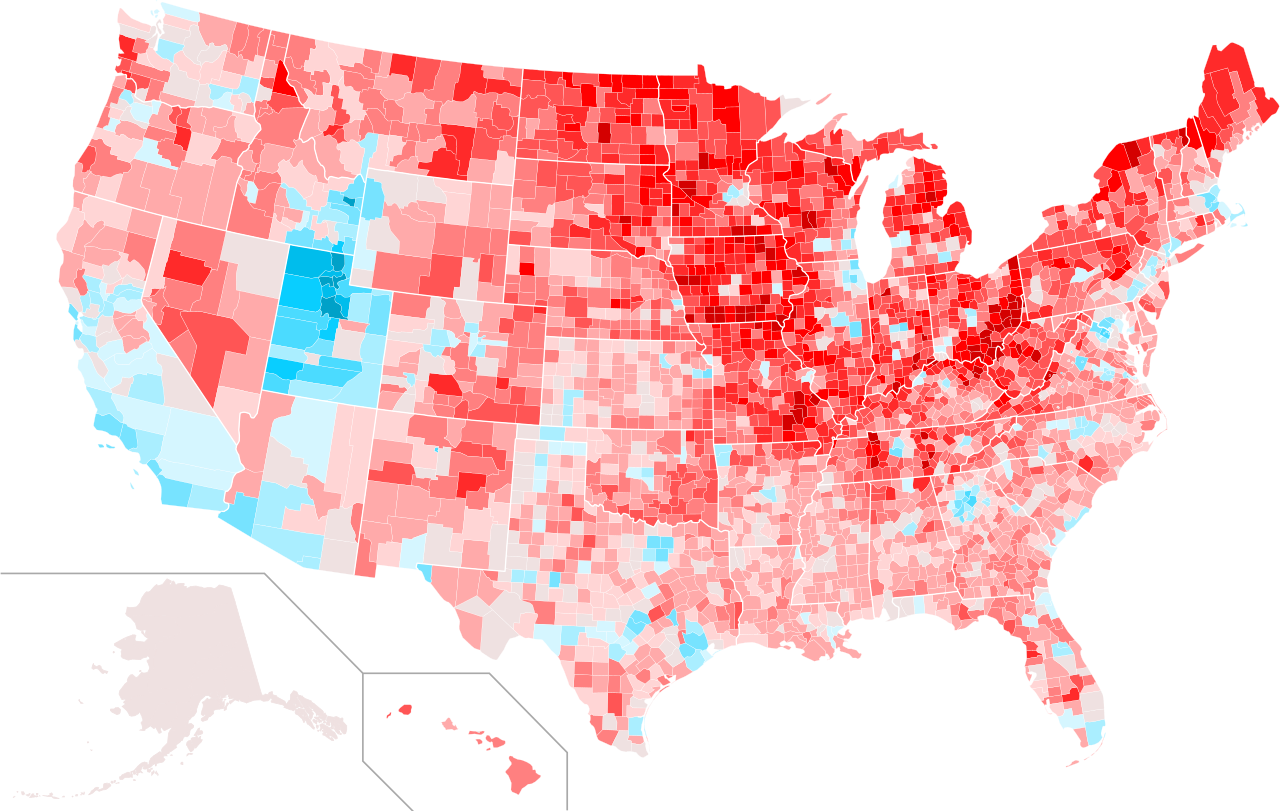Over 30 counties in Iowa pivoted for Trump by over 15% in 2016, and none reverted in 2020. This trend is not a fluke- it is the new political reality for the Heartland.
1 June, 2021
Throughout the second decade of the 21st Century, a political sea change has been occurring in a region of the United States far removed from any oceanic body. Nationally, 206 counties flipped from an Obama victory in 2012 to favoring Trump in the 2016 Presidential election. 90 (44%) of these “pivot” or swing counties were in the “Midwest” states of Illinois, Indiana, Iowa, Minnesota, and Wisconsin. Including states under the Census Bureau’s regional definition, this figure jumps to 61%. Nebulous geographic distinctions aside, 30 of these pivot counties are in my home state of Iowa. Zero of these Iowa counties reverted to Joe Biden in 2020 (compared to a modest 25 counties nationally.) Despite being a relatively competitive state, with an even 1 to 1 win ratio between Republican and Democratic Presidential candidates between 1976-2012 at an average vote margin of 6.9%, Iowa has moved radically towards the Republican party in the past decade.
Neither Biden in 2020 nor Clinton in 2016 won a plurality of votes in any of Iowa’s Congressional Districts, although Biden came within 600 votes of winning Iowa’s 3rd, home to the state’s capital city and most populous urban metro Des Moines. Iowa was the site of three of the 22 closest US elections in 2020, including the closest federal election since 1984 in Iowa’s 2nd Congressional District, where Republican Mariannette Meeks-Miller defeated Democrat Rita Hart for an open Congressional seat vacated by Dave Loebsack by just six votes.
If we look only at 2020 federal-level election results, Iowa Democrats have little reason to despair. After all, if Democrats were able to mount near-majorities in 75% of the state’s Congressional Districts, certainly these razor-thin margins can be easily overcome by capitalizing on the popularity of many of Biden’s policies. But such a narrow perspective on Iowa politics errs to the point of myopia.
From 2012-2020, Iowa Republicans gained 15 seats in the General Assembly, wresting control of the Senate in 2016 after a landslide gain of six seats to establish a “trifecta” unified government. Most incredibly, Iowa Republicans gained six State House seats and added two US House seats in 2020, an election year with a Democratic Presidential victory. During 2012-2020, Republicans in Iowa also maintained control of Terrace Hill in both gubernatorial contests, won all three US Senate elections, and won ten US House elections.
This barrage of statistics begins to reveal the scope of partisan dominance achieved by Republicans in Iowa at every level of government. The factors that led the once bellwether swing state towards a sustained Conservative majority, replicated to varying degrees across the region, are determinantal in the daily lives of Midwesterners and in the upcoming 2022 elections. If Democrats want to be competitive in Iowa and the Midwest in 2022 and 2024, they cannot dwell on a forthcoming retrospective analysis. A proactive assessment on what caused these extreme electoral trends is necessary for strategizing successful campaigns in the present. At stake is no less than the viability of Midwestern Democrats, and millions of fates that hang in the balance of municipal, state, and federal policymaking. Elections are, after all, only a preamble to self-government.
Benjamin A. Craighton
- Ali Zifan and Magog, the Ogre (talk) (contribs) – File Derived from: USA Counties.svg, Creative Commons, CC0.
- Fahey, M. and Wells, N. “The places that flipped and gave the country to Trump.” The Big Crunch. n.d. CNBC.
- Hickey, W. “Which States Are in the Midwest?” Fivethirtyeight. Published 29 April, 2014. ABC News.
- RP [Randy P.] “IA – District 02.” OurCampaigns. Published 18 Dec, 2020. Data derived from Iowa Secretary of State’s Office.
- Wishful Thinking [Randy P.] “Iowa – State Details.” OurCampaigns. Published 22 March, 2020. Data derived from Iowa Secretary of State’s Office.
- “Biden Viewed Positively on Many Issues, but Public Is Less Confident He Can Unify Country.” American Trends Panel. Published 11 March, 2021. Pew Research Center.
- “Census Regions and Divisions of the United States.” US Department of Commerce, Economics, and Statistics Administration. n.d. US Census Bureau. Geography Division.
- “Election results, 2020: Pivot Counties in the 2020 presidential election.” Ballotpedia. Published 4 Jan, 2021. Ballotpedia.
- “Election results, 2020: Reverse-Pivot Counties.” Ballotpedia. Published 6 Jan, 2021. Ballotpedia.

